Cards that I have
These are the cards that I actually have. The XML and stylesheet are also available. Just like everything else on the web, this is still a work in progress. I have pretty much all my cards listed, but there are some additional details that still need to be added for some. I also intend to add pictures of all (or at least most) of the cards. That and I'm always adding more cards to my collection. :)
3dfx
I just noticed this card in my box. I know that I bought it at Free Geek, but I don't remember exactly when.
 |
Free Geek's $2 "untested" card box comes to the rescue! I guess this means I have to do some work on the tdfx DRI driver, huh?
3dlabs
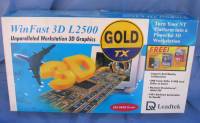 |
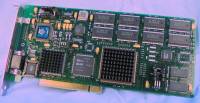 |
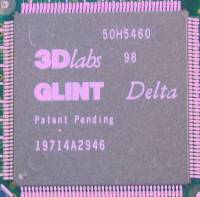 |
I don't think a lot of people realize it, but this was the first card to get hardware accleration, using Mesa, in XFree86. I'm pretty sure that this driver predated even the Glide based Mesa port for 3dfx cards. In fact, the guys that did the driver used something very similar to the DRI model. There was a small kernel module that handled submitting commands and receiving interrupts, and there was a client-side driver that did the real work. One of these days, I'd love to resurrect that work in a DRI driver.
 |
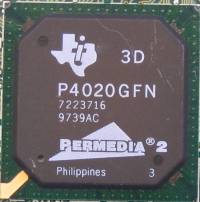 |
The Permedia2 was, alas, one of 3dlabs' worst performing chips. In fact, this was the chip used to provide boot-strap VGA support on the GMX 2000 cards. However, there are a zillion of them in circulation. Not only that, but there are Permedia2 boards available for PCs, PowerMacs, Sun workstations, and, believe it or not, Amigas. Since all of the Glint family of chips are pretty similar, it shouldn't be too difficult to get the Permedia2 supported by the gamma driver...once the gamma driver is working again.
This is another happy acquisition from Free Geek. This one was really expensive! It was $5! ;)
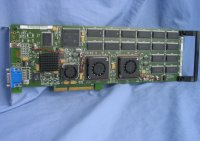 |
This is another card that I bought so that I could resurrect its driver. As far as I remember, this was the first card to get DRI support, so it seems appropriate to get it working again. The ideal sollution would be to create a new unified driver that supported this card and the 500TX.
 |
 |
I wasn't even looking for one of these, but when I saw it in Free Geek's $5 box, I couldn't resist. I doubt I'll be able to get 3D working on this card since the R3 / Permedia 3 is pretty different from the previous chips in the series. shrug Dunno.
ATI
My dirty secrets come out...I never used to like ATI. I remember giving my uncle hell for buying a Rage (the original, not the IIc or Pro) instead of an S3 Virge or Trio. I never was too impressed with the Rage Pro or the Rage128. However, that all changed with the Radeon. Ever since I got my first R100 based card, I've been an ATI fanboy. I think part of the reason is that, when the Radeon first came out, ATI was the under dog. Nvidia and 3dfx owned the market, and most people felt about the same as I about the Rage family.
I guess now that ATI has replaced 3dfx as Nvidia's top rival I need to find a new under dog. Maybe.
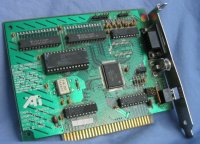 |
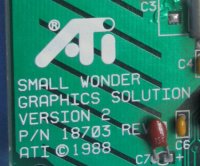 |
I was going through some boxes of stuff looking for things to sell on eBay and craigslist. While going through one of the boxes, I came across this gem. I have no idea how or when I got it. I think it was in a box with some other stuff that I bought. Dunno.
The thing that makes this old EGA card intersting is that, as far as I know, ATI is the only company, other than IBM, that made EGA cards that's still around. I know that some of the other companies are technically still around, but since they've all been bought and sold at least once, I don't count them.
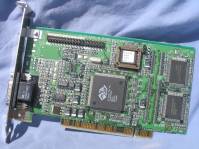 |
Let this be a lesson! Become good friends with the guy at your company that processes systems that are being replaced. He's a good source for old "stuff". It's like Chirstmas in October. Hopefully I'll get a chance to do a little hacking on this card some day.
I somehow acquired two additional 4MB cards, but I don't know how or when. shrug If anyone wants to borrow one for X hacking, let me know.
This is just the basic card that shipped with the original AGP G4 PowerMacs. In fact, that's where I got this card. It came in the "blazing fast" 450MHz G4 that I use for some testing. If it weren't for cross-compilers, I'd be toast!
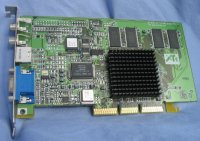 |
I originally bought this card for my wife's (she was my girlfriend at the time) computer. She wanted to be able to watch TV and DVDs on her computer. I hooked an old VCR up to the TV-in port so that she could watch TV, and the iDCT support on the Rage128 was enough to make DVDs watchable on her K6-2 500.
After she moved on to a Mac, I kept the card for DRI testing / development.
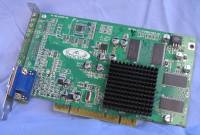 |
So, this is probably my least favorite of all the Radeons, although I'm not to fond of the RN50 either. Anyway, there are tons of problems that crop up on these cards. When I saw one for $5 at Free Geek, it was my duty as an X.org developer to get it. Well...something like that, anyway.
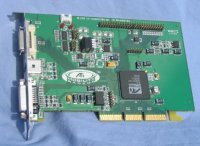 |
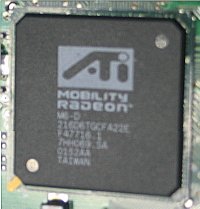 |
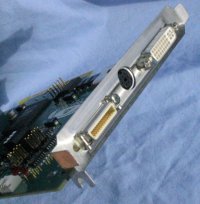 |
I have almost no recollection how I acquired this rare card. I vaguely recall that someone within IBM was using the M6 in some embedded Linux project, and they were having some problem with the 2D driver. They sent me this card in hopes that I could track the problem down. I guess my reward for being so helpful was to hang on to the card.
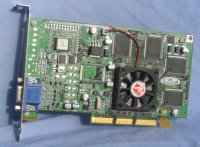 |
This is the original 32MB Radeon DDR. This is from back before ATI's funky numbering system. This card would eventually be renamed the Radeon 7200.
This is the card that I used to first start hacking on DRI. I originally paired this card with a 500MHz Celeron on a 440LX based motherboard. At the time, it was quite the hot setup. I also managed to impress my friends with a whopping 256MB of SDRAM.
After keeping this card for several generations of motherboards, I finally replaced it with a Radeon 8500LE. After another motherboard upgrade (to an i845GE based board), I put the card back in my system for testing. I was crushed when it wouldn't boot! For some silly sentimental reason, I kept the card anyway. Years later, on a whim, I tried putting the card in an old KT133A based board that I use for testing. Guess what? It worked! It seems that the i845GE just does not like the original R100.
In a bit of irony, the Radeon 8500LE does not work on the KT133A board. I just love the AGP "standard".
There's actually a funny story behind my acquisition of this card. A number of years ago Linus Torvalds was complaining on the DRI mailing list that TuxRacer looked awful on his kid's PC due to broken DOT3 bump-mapping in the r200 driver. I looked in the driver, thought I had a fix (I had already done similar code in the r100 driver), but I had no hardware for testing.
I took all that information to my (normally very budget consious) management, and I had the card in less than a week...and Linus had a working patch just a couple days later.
This card was my primary display adapter for nearly 3 years. It was eventually replaced by a Radeon 9600XT.
 |
This is the PCI Mac Edition. It cost about 3x the AGP PC edition. Good times! I acquired this card to get some good graphics going under Linux on a pSeries box (a nice dual 1.4GHz POWER4 box with 1GiB RAM, to be exactly). However, there is some sort of firmware problem that prevents this card from working in that box...at all. Some fine lads at IBM are looking into the problem.
My previous work laptop was a Thinkpad T21, and its replacement was a nice, shinny Thinkpad T41p. What an upgrade! I was really tempted to pry it open to take a picture of the chip. I figured that if I broke it I'd be in deep doo-doo. Common sense won this time.
I added this card to my collection just before a LAN party in February of 2006. The card is a Sapphire Radeon X800GTO "FireBlade Special Edition." It's quite fast, but, in my quiet basement, the fan sounds like a leaf blower.
IBM
Please don't ask me why there aren't any Linux drivers for these cards.
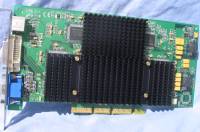 |
 |
 |
Intel
Believe it or not, in terms of raw volume, nobody ships more graphics chips than Intel. It makes pretty good sense for me to have some Intel chips and be familiar with the drivers. Just please, please don't make me use them for 3D. They have all the functionality and a very nice programming interface, but the performance just isn't there.
Around the middle of 2004, my Thinkpad T21 was on it's last legs. The hard drive was getting read errors, the case was cracked, and the CD-ROM would occasionally "disappear". I knew I was coming up for a replacement in the normal cycle pretty soon, but I needed something in the mean time. I scrounged around and found this laptop listed as surplus. Not only did it hold me over until the Thinkpad T41p was available, but it has also given me another Intel graphics card for hacking.
I'm pretty impressed with the performance of this Core 2 Duo setup. The performance of the integrated graphics isn't anything to write home about, but the drivers are completely open source, and Intel and Tungsten Graphics improve them on a regular basis.
I got this board as a loaner from Intel in November 2006.
Matrox
Some how I've ended up with a decent size collection of Matrox cards. I'm also gradually ending up as the maintainer for the MGA driver. I'm not sure which is the chicken and which is the egg. In a way, this almost makes sense. The very first video card that I had for a PC was a Matrox Impression+. That card was pretty cool. It had this neat mode where it emulated 24-bit color using 8-bit color and hardware dithering. In 1995, that was cool stuff!
That card did have some serious drawbacks. It supported hardware accelerated Z-buffering and gouraud shading, but you had to use a library (read: closed-source driver) from Matrox that only worked with Watcom C. At the time, I was using DJGPP. In addition, regular VGA access on that card was painfully slow. It was the only PCI graphics card I've ever seen that played Doom slower than an ISA VGA card.
 |
Another treat from the surplus hardware guy. I have zero intention of trying to do any sort of 3D driver for this card, so don't even ask! However, it will help me to verify that my changes to the 2D driver don't cause regressions on this chip.
I take that back, if this card supports alpha blending (and I'm 90% sure that it doesn't), I might try to hack something up someday. I can guarantee that the G100 will get a driver first.
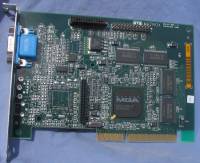 |
I picked up this card in July of 2005. I got it for two reasons. One, I have sick dreams of hacking up 3D support for it. Two, so that I could verify that changes I had made to the MGA 2D driver hadn't broken this card. Guess what? They did. Good thing I got the card, huh?
 |
This is another Free Geek find. I had to pay a whole $5 for this one, though. Now I just need to get the 8MB memory upgrade SO-DIMM.
 |
I actually have two of these. They were sent to me by someone inside IBM so that I could have a card with DRI drivers to hack on. So, that would have been some time in the first half of 2001.
This is an AGP G400 MAX for the Mac. It was released in 2001, and not very many of them were made. The card was targeted at G4 Cube owners that wanted dual-head. At the time, it was the only single-slot, dual-head configuration. However, the problem was that there were no OpenGL drivers for the card. Ouch. There is also no OS X support. Ouch-ouch!
Since I knew I was going to have to support a PCI G450 on PowerPC, I wanted to get a head start with the AGP version. I bought one on eBay for $3 + $7 shipping. When I put the card in a Sawtooth G4 PowerMac, it wouldn't boot. Undaunted, I got another one on eBay for $1 + $8 shipping. It did the same thing. The odds of getting two dead cards from two different sellers seemed pretty low to me.
I thought perhaps the cards needed new system firmware. I got an OS 9.2.1 disc, installed it, updated to the latest firmware, and installed the card. In OS 9, the card works perfectly. I put Linux back on the system, but I set it up for dual-boot this time around. With the card in the system, the boot process completely ignores yaboot, finds the OS 9 partition, and boots that. WTF?!? When the card is in the system I am also unable to get to the OpenFirmware prompt. This happens with both cards that I have.
I've got a couple people at OzLabs (benh included) looking at one of the cards trying to find a work-around. The G400 MAX is a decent performer, and these cards are basically free (if you can find one). It seems reasonable to want to get it supported on PowerPC.
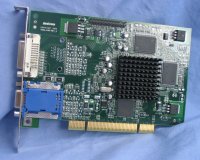 |
 |
This card is probably stranger than the ProMax card. Not only is this card for PowerPC, but it's also PCI. Until fairly recently, this was the only G400-class card that wasn't AGP. This card came in a sweet pSeries box. Since there is so little demand for MGA support on PowerPC or for PCI MGA, the card fails in all kinds of ways. 2D works pretty well on PPC32 (3D is hosed), but everything is kaput on PPC64.
The PLX chip between the G450 chip and the PCI connector is a universal PCI-to-PCI bridge. That does the electrical translation between AGP and PCI. Sorry the picture is so bad.
Perhaps the most interesting thing about this card is the fact that it works in both PowerPC boxes (presumably any OpenFirmware system) and x86 boxes. I have run this card in both an Athlon XP and an Athlon64 system. Weird, huh? I suspect that all PCI G450 cards will work in both, but I have no way to verify that one way or the other.
 |
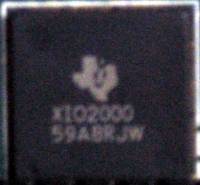 |
No kidding, Matrox really does make a PCI-Express G550. Like the PCI G450, the PCI-e G550 is actually an AGP G550 with an AGP-to-PCI-e bridge chip.
This card is a loaner from someone at work. I think I'm going to get an ASUS A8V-MX motherboard to go with it. Those boards have an AGP slot, a PCI-e x1 slot, and two PCI slots. I could put an AGP G400 dual-head card, a PCI G450 dual-head card, and the PCI-e G550 dual-head card in it all at once. Why? Because I can. :)
Number 9
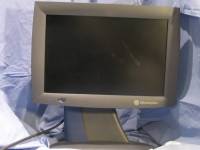 |
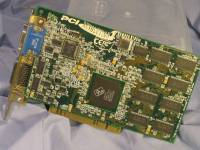 |
What can I say? I'm a sucker for quirky hardware, and this is quirky. This is an uncommon card from a dead company, but it is one of only two cards that directly support the SGI 1600SW wide-screen display. In fact, I acquired it via craigslist with a 1600SW for a mere $60. There is a 1 pixel wide green line about 1cm from the right side of the display, but, for that price, I can live with it.
Nvidia
All of my friends were upgrading their Monster 3D cards to various Voodoo2 based cards. As usual, I wanted to be different. That started a brief period of Nvidia fanboyism. I only lasted for two generations of cards (the TNT and TNT2), but it was pretty cool while it lasted.
I still have a lot of good things to say about Nvidia's hardware and the quality of their software. I just can't get over their complete unwillingness to share technical documentation for even their oldest cards. Seriouslly...<soapbox>what could they possibly lose at this point by giving out information for the NV3?</soapbox>
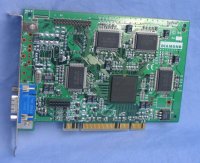 |
 |
I have no clue when or where I got this card. I know I've had it since at least 1998, though. I think I've mostly kept it (and its TNT & TNT2 cousins) around so to port the Utah GLX driver to DRI. I'm particularly interested in seeing this driver ported to DRI because the NV3 (and the NV1, but nevermind that) is the only Nvidia chip not supported by their close-source drivers. I'll get to it one of these days...
This was my first "single card" 3D accelerator. It replaced the Canopus Pure 3D (with 6MB of memory that was the envy of all my friends) that replaced the Matrox m3D. I seem to recall that I got the PCI version because I put it on a 440FX based PentiumPro board.
I found an old blog of mine. I bought this card on March 15th, 1999. According to the entry, it was "my first PC upgrade in about a year." The previous major purchase was the afore mentioned Pure3D.
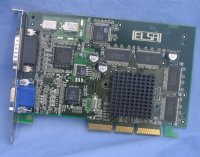 |
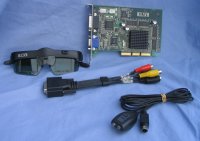 |
I was so psyched to get this card! Not only was it faster than the TNT that it replaced, but it had 3D glasses! At the time, I was having LAN parties almost every month, and I was ready for any advantage I could get. There was just one problem...
When a game like Quake is converted to stereo 3D, you visually end up with 2 gun sights. This is just like looking down a real gun with both eyes. However, that's not how you really shoot. You close one eye so that there is only one sight, and that enables you to aim. Well, I very quickly started doing the same thing in the game. Uh...so, I've got stereo glasses, but I need to close one eye to kill stereo effects so that I can actually aim. D'oh!
This is another card that I don't really remember how or when I acquired. I seem to recall getting it for one of my extra computers, but I'm not sure. The one thing that I do remember is that I put it in my network server and used a tweaking program to lower the core clock as low as it could go to keep power consumption down. Remember, this was the die-shrunk TNT2 that used much less power than a TNT2 or a TNT2 Ultra.
Rendition
 |
 |
S3
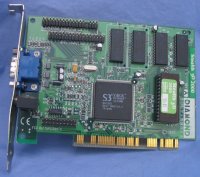 |
Of all the cards in the collection, this is the one I've had the longest. I bought it new in 1996. It was paired with a 60MHz Pentium (overclocked to 66MHz! w00t!) and played Doom pretty well. It lasted for a short while after Quake came out, but glquake killed it.
Just to be different, I got a Matrox m3D (based on a PowerVR PCX2) instead of a Monster 3D. That was an interesting card, but the drivers were Crap (yes, with a capital C!).
I have no idea why I still have this card or if it even still works. I looked at the source to the s3v DRI driver, and that made me consider burning the card just on principle!
This is another card that I scavanged from an IBM desktop system. I grabbed the card in 2002 in hopes of working on the Savage driver before S3 released the source for their driver. In August / September of 2005 I was finally able to make some trivial enhancements to the driver.
Revision History | |||
| 2008-Mar-25 11:01 PST | Removed some cards that I have gotten rid of over the last year. |
||
| 2007-Mar-09 13:10 PST | Added pictures for the X850XT PE, Revolution IV, and Banshee. Added PCI ID info for the Banshee. |
||
| 2007-Mar-06 15:40 PST | Added entries for the Voodoo II, G965, X850XT PE, Revolution IV, and 7600GT. |
||
| 2006-Aug-20 18:20 PDT | I was taking some pictures for some eBay auctions, so I decided to take pictures of the Permedia 2, VX1, Radeon 7000, and the 500TX. I also correct the entries for the GXT4500 and GXT6500. |
||
| 2006-Jul-29 19:25 PDT | Added the Permedia 2, VX1, and Radeon 7000 acquisitions from yesterday's Free Geek trip. |
||
| 2006-Mar-24 11:39 PST | While waiting for a full modular X.org build to complete, I added pictures of the FireGL 2, GXT4500P, GXT6500P, Quadro4, Stealth S220, Millennium (2064W), G100 AGP, G200 AGP, and G400 AGP. Whew! |
||
| 2006-Mar-22 13:46 PST | Added PCI-e G550 pictures. |
||
| 2006-Mar-09 10:35 PST |
Added the PCI-e G550 entry. Added the bit about the PCI G450 working on both PowerPC and x86. |
||
| 2006-Feb-10 10:33 PST | Added the "Stealth S220" that I got via a cool trade on Monday. |
||
| 2005-Nov-02 09:30 PST | Added the "Ensoniq 3D Banshee" and "Millennium G200" that I bought at Free Geek last night. |
||
| 2005-Oct-17 11:00 PDT | After finding an old blog entry from my old LAN party website, I added some information about the Graphics Blaster TNT. |
||
| 2005-Oct-11 15:58 PDT | Updated PCI ID information for the various TNT / TNT2 cards. I had put the cards in systems to test ajax's NV EXA patch. |
||
| 2005-Oct-07 13:00 PDT | Added the ATI RagePro to the list. |
||
| 2005-Oct-07 11:45 PDT | Sorted companies by name (instead of randomly). |
||
| 2005-Aug-28 18:42 PDT |
Added pictures. I was taking pictures of some other stuff to post on eBay and craigslist, so I decided to take pictures of some of the cards that weren't in systems. Added the EGA Wonder card to the list. |
||
| 2005-Aug-02 10:15 PDT | Corrected the memory size and added the PCI ID for the
GXT135P. |
||
| 2005-Aug-02 09:15 PDT | Initial version. |
||